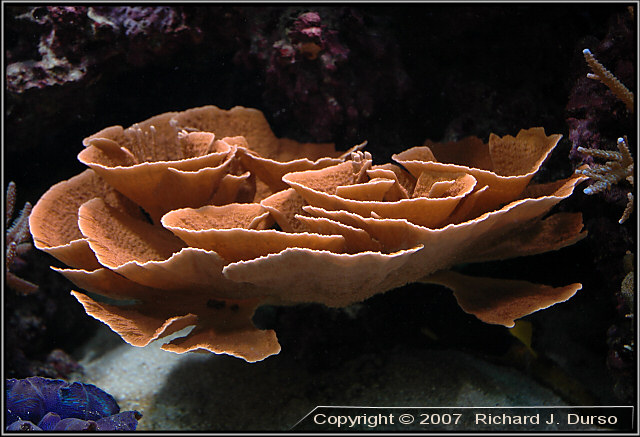DEATH OF A WRASSE
Unfortunately, my husband did not see the wrasse until he came home from work and by that time, he was all nice and crispy. I am disappointed because he was such a cool fish but relieved at the same time because he was major PITA.
THE GHA MENACE
In other news, while I was gone husband failed to do regular water changes resulting in GHA outbreak (Green Hair Algae). The tank looks super gross and these photo were taken after I had removed 70% of what had been there by hand, started running GFO, and added Consuela and her helper:
 |
| There is more algae in the caves |
The solution to our problem is simply to pick off what we can and do a combination of starving out and increase predation on the rest.
 |
| That clump of algae is actually a snail. |
How we starve out the algae is increase the water changes. The water changes will help remove excess nutrients from the water column and limiting the food access to the GHA. The next step in starving out the algae is running GFO and carbon. I already run carbon in the tank to help control nutrients and keep the water clear, but this is my first time running GFO. GFO stands for Granulated Ferric Oxide. It's primary purpose is to strip phosphates from the tank. There are many brands, the one I am using is PhosGuard from SeaChem. I got an unopened bottle from my husband's friend who was leaving the hobby. I'm really grateful for that considering the bottle costs about $40.
Since being in this hobby, if there is one thing I have learned most of the people involved from the hobbyists to even the vendors genuinely enjoy what they are doing and therefore are more than willing to give customers or online acquaintances freebies or free help. A lot of the people I have meet doing this hobby are really good natured and generous. It makes me really happy that people can still be so kind to strangers. However, I digress.
I am suppose to run the GFO for four days and then check my phosphate levels again. If they've dropped, I pull the GFO out. If not, I replenish it and run for another four days. GFO is not meant to be run 24/7. It's one of those use it when you need it.
PHASE TWO: INCREASED PREDATION
 |
| it's even growing on my GSP! |
Out of my original CUC, one hermit crab and four snails remain. This is definitely not enough for my tank or enough to tackle the GHA outbreak. So, I cruised on over to my friendly Reef Cleaners website and purchased a new CUC via their Quick Cleaner Packages. The Quick Cleaner Packages are based on tank size. For a 20 gallon long tank, I am getting 45 critters to clean my tank.
 |
| Consuela, you're our only hope! |
Emerald Crabs are suppose to be beasts at eating algae. So far, they have been really fun to watch, They rip big chunks of algae up. When we bought them, they were in a tank with very little algae started to try and eat each other on the way home. They've been eating machines ever since we've put them in the tank.
The Emerald Crab has lovingly been dubbed Consuela from Family Guy. I hope the crab has her tenacity and stubbornness. With her and her massive army, I'm expecting great results :-D. I hope to have this problem cured in a month.






















